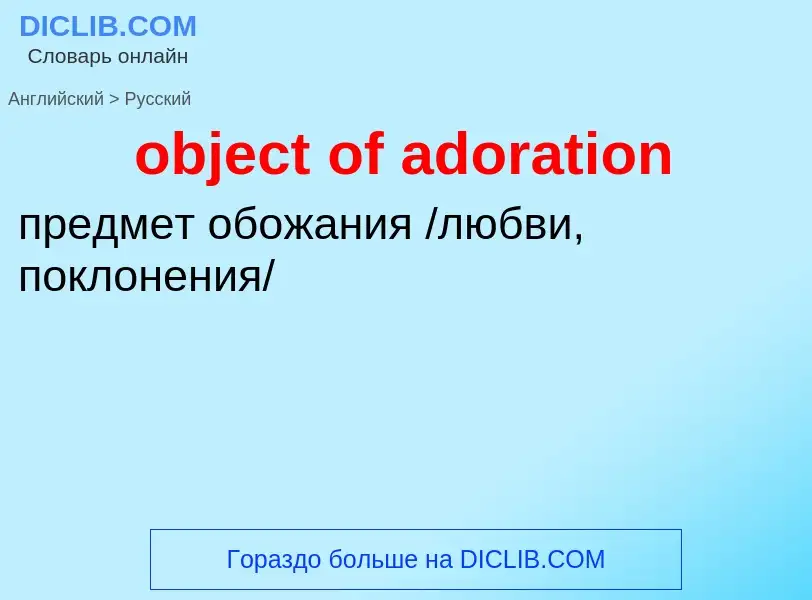Translation and analysis of words by ChatGPT artificial intelligence
On this page you can get a detailed analysis of a word or phrase, produced by the best artificial intelligence technology to date:
- how the word is used
- frequency of use
- it is used more often in oral or written speech
- word translation options
- usage examples (several phrases with translation)
- etymology
object of adoration - translation to russian
общая лексика
косвенное дополнение
Definition
.
Wikipedia

The Adoration of the Magi or Adoration of the Kings or Visitation of the Wise Men is the name traditionally given to the subject in the Nativity of Jesus in art in which the three Magi, represented as kings, especially in the West, having found Jesus by following a star, lay before him gifts of gold, frankincense, and myrrh, and worship him. It is related in the Bible by Matthew 2:11: "On entering the house, they saw the child with Mary his mother; and they knelt down and paid him homage. Then, opening their treasure chests, they offered him gifts of gold, frankincense, and myrrh. And having been warned in a dream not to return to Herod, they left for their own country by another path".
Christian iconography considerably expanded the bare account of the Biblical Magi described in the Gospel of Matthew (2:1–22). By the later Middle Ages this drew from non-canonical sources like the Golden Legend by Jacobus de Voragine. Artists used the expanded Christian iconography to reinforce the idea that Jesus was recognized, from his earliest infancy, as king of the earth. The adoration scene was often used to represent the Nativity, one of the most indispensable episodes in cycles of the Life of the Virgin as well as the Life of Christ.
Stories throughout the Middle Ages started circulating, which speculated who exactly were the three kings who were famous for visiting the Christ child. Many people assumed that they came from somewhere in the east. Eventually it was decided that the three kings would represent the three main continents at the time; Europe, Asia, and Africa. The three names that prevailed over the centuries for the three kings were Gaspar (or Caspar), Melchior, and Balthasar. The prominence of this story, as well as the three kings or magi, is due to the great theological significance that the Biblical story holds, their exotic clothes and looks, as well as their great and expensive gifts.
In the church calendar, the event is commemorated in Western Christianity as the Feast of the Epiphany (January 6). The Eastern Orthodox Church commemorates the Adoration of the Magi on the Feast of the Nativity (December 25). The term is anglicized from the Vulgate Latin section title for this passage: A Magis adoratur.


![Adoration of the Child Jesus by the three wise men or Magi; [[Sarcophagus]] relief (4th century), Vatican Adoration of the Child Jesus by the three wise men or Magi; [[Sarcophagus]] relief (4th century), Vatican](https://commons.wikimedia.org/wiki/Special:FilePath/Adoration magi Pio Christiano Inv31459.jpg?width=200)

![Fra Angelico and Filippo Lippi]], mid-15th century Fra Angelico and Filippo Lippi]], mid-15th century](https://commons.wikimedia.org/wiki/Special:FilePath/Fra Angelico, Fra Filippo Lippi, The Adoration of the Magi.jpg?width=200)
![''Adoration of the Magi'']], [[Gentile da Fabriano]], 1423 ''Adoration of the Magi'']], [[Gentile da Fabriano]], 1423](https://commons.wikimedia.org/wiki/Special:FilePath/Gentile da fabriano, adorazione dei magi.jpg?width=200)
![[[Hugo van der Goes]], [[Monforte Altarpiece]], c. 1470 [[Hugo van der Goes]], [[Monforte Altarpiece]], c. 1470](https://commons.wikimedia.org/wiki/Special:FilePath/Hugo van der Goes - The Adoration of the Kings (Monforte Altar) - Google Art Project.jpg?width=200)
![''Adoration'' by Jan Gossaert]], 1510-15 ''Adoration'' by Jan Gossaert]], 1510-15](https://commons.wikimedia.org/wiki/Special:FilePath/Jan Gossaert 001.jpg?width=200)
![[[Giotto di Bondone]], 1320–1325 [[Giotto di Bondone]], 1320–1325](https://commons.wikimedia.org/wiki/Special:FilePath/Giotto di Bondone - The Epiphany - WGA09343.jpg?width=200)
![[[Giotto]], [[Scrovegni Chapel]] [[Giotto]], [[Scrovegni Chapel]]](https://commons.wikimedia.org/wiki/Special:FilePath/Giotto - Scrovegni - -18- - Adoration of the Magi.jpg?width=200)
![Grey family]] of Ruthin, c. 1390 Grey family]] of Ruthin, c. 1390](https://commons.wikimedia.org/wiki/Special:FilePath/De Grey Hours f.71.r Adoration of the Magi.png?width=200)
![[[Saint-Thiébaut Church, Thann]], around 1400 [[Saint-Thiébaut Church, Thann]], around 1400](https://commons.wikimedia.org/wiki/Special:FilePath/Collegiale-Thann-p1010095.jpg?width=200)

![[[Hans Memling]], 1470 [[Hans Memling]], 1470](https://commons.wikimedia.org/wiki/Special:FilePath/Hans Memling 028.jpg?width=200)
![[[Jean Fouquet]]; one of the magi is King [[Charles VII of France]] [[Jean Fouquet]]; one of the magi is King [[Charles VII of France]]](https://commons.wikimedia.org/wiki/Special:FilePath/L Adoration des Mages.jpg?width=200)
![Botticelli, 1475]] Botticelli, 1475]]](https://commons.wikimedia.org/wiki/Special:FilePath/Botticelli - Adoration of the Magi (Zanobi Altar) - Uffizi.jpg?width=200)
![Domenico Ghirlandaio, 1485-88]] Domenico Ghirlandaio, 1485-88]]](https://commons.wikimedia.org/wiki/Special:FilePath/Adoration of the Magi Spedale degli Innocenti.jpg?width=200)
![[[Giorgione]], c. 1505 [[Giorgione]], c. 1505](https://commons.wikimedia.org/wiki/Special:FilePath/Giorgione 010.jpg?width=200)
![''Adoration'', Jan Mostaert]], 1520s ''Adoration'', Jan Mostaert]], 1520s](https://commons.wikimedia.org/wiki/Special:FilePath/De aanbidding van de koningen Rijksmuseum SK-A-671.jpeg?width=200)
![[[Jacopo Bassano]], 1563–1564 [[Jacopo Bassano]], 1563–1564](https://commons.wikimedia.org/wiki/Special:FilePath/Jacopo da Ponte 001b.jpg?width=200)
![[[Icon]], [[Cretan School]], early 17th century [[Icon]], [[Cretan School]], early 17th century](https://commons.wikimedia.org/wiki/Special:FilePath/The Nativity and the Adoration of the Magi - Google Art Project.jpg?width=200)
![[[Diego Velázquez]], 1619 [[Diego Velázquez]], 1619](https://commons.wikimedia.org/wiki/Special:FilePath/Velázquez - Adoración de los Reyes (Museo del Prado, 1619).jpg?width=200)
![Rubens, Lyon]], c. 1617–1618 Rubens, Lyon]], c. 1617–1618](https://commons.wikimedia.org/wiki/Special:FilePath/Rubens-adoration des mages.jpg?width=200)
![[[Abraham Bloemaert]], 1624 [[Abraham Bloemaert]], 1624](https://commons.wikimedia.org/wiki/Special:FilePath/Abraham Bloemaert - The adoration of the Magi - Google Art Project.jpg?width=200)
![[[Pieter van Lint]], 1630 [[Pieter van Lint]], 1630](https://commons.wikimedia.org/wiki/Special:FilePath/Pieter van Lint - Adoration of the Magi.jpg?width=200)
![Rubens, Cambridge]], 1634 Rubens, Cambridge]], 1634](https://commons.wikimedia.org/wiki/Special:FilePath/Peter Paul Rubens 009.jpg?width=200)
![Rubens, 1624]], in [[Royal Museum of Fine Arts Antwerp]] Rubens, 1624]], in [[Royal Museum of Fine Arts Antwerp]]](https://commons.wikimedia.org/wiki/Special:FilePath/Aanbidding door de koningen, Peter Paul Rubens, (1624), Koninklijk Museum voor Schone Kunsten Antwerpen, 298.jpg?width=200)
![[[Rembrandt]], 1632 [[Rembrandt]], 1632](https://commons.wikimedia.org/wiki/Special:FilePath/Magi-rembrandt.jpg?width=200)
![[[Bartolomé Esteban Murillo]], 1655–1660 [[Bartolomé Esteban Murillo]], 1655–1660](https://commons.wikimedia.org/wiki/Special:FilePath/Bartolomé Esteban Murillo - Adoration of the Magi - Google Art Project.jpg?width=200)
![Domingos Sequeira, 1828]] Domingos Sequeira, 1828]]](https://commons.wikimedia.org/wiki/Special:FilePath/A Adoração dos Magos (1828) - Domingos Sequeira.png?width=200)
![Tapestry]], [[Edward Burne-Jones]], [[Musée d'Orsay]], 1887 Tapestry]], [[Edward Burne-Jones]], [[Musée d'Orsay]], 1887](https://commons.wikimedia.org/wiki/Special:FilePath/Edward Burne-Jones - The Adoration of the Magi - Google Art Project.jpg?width=200)
![Fragment from medieval fresco, [[Kremikovtsi Monastery]] Fragment from medieval fresco, [[Kremikovtsi Monastery]]](https://commons.wikimedia.org/wiki/Special:FilePath/Magi-from-Kremikovtsi.jpg?width=200)
![Stained glass, [[St. Michael's Cathedral (Toronto)]] Stained glass, [[St. Michael's Cathedral (Toronto)]]](https://commons.wikimedia.org/wiki/Special:FilePath/Adoration of the magi st.michael toronto.jpg?width=200)
